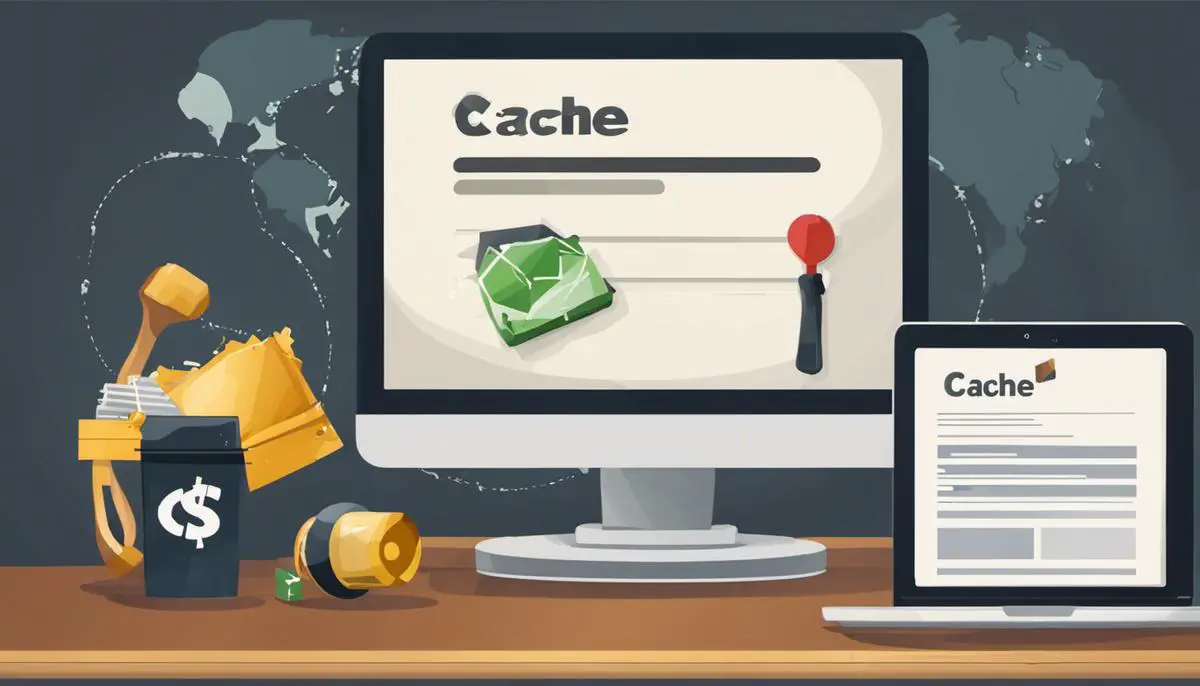In this fast-paced digital world, websites and applications strive to provide an efficient and seamless user experience. One key aspect is ensuring rapid and reliable content delivery. Here is where the concept of caching enters, essentially storing data temporarily to hasten its delivery upon request. However, this process brings forth the problem of serving outdated or stale content to users. Therefore, cache busting, an often overlooked yet integral facet of web development and maintenance comes to the fore. This practice ensures users always receive the most recent content, even in dynamic, frequently updated websites, hence enhancing the user experience and maintaining website integrity.
Definition and importance of cache busting
Definition of Cache Busting
Cache busting is a technique used in web development which forces the browser to download a newer version of a web file instead of serving the cached, or stored, version. This is crucial when there are updates or changes to a website that necessitates the user to receive the latest version of the available files. When web files are cached, it allows for faster load times and less strain on the server because the files are stored on the user’s local machine. However, this can be problematic when those files are updated on the server but the user’s machine continues to serve the older, cached version.
How Caching Operates
Caching is a method that browsers use to save time and resources when loading websites. When you visit a website, your browser will often store, or cache, certain parts of that website on your local hard drive. These parts may include HTML files, CSS style sheets, Javascript files, and media such as images and videos. Next time you visit that website, your browser will load these cached files instead of retrieving the originals from the server, thereby speeding up page load times.
Benefits of Caching
Caching offers several advantages in web development. It can significantly improve web performance by reducing load times. This is especially beneficial for repeat visitors to your website or for those with slow internet connections. Further, it reduces the load on the web server. Instead of the server having to process every single request for web files, it can focus on processing unique or updated content.
Drawbacks and Solutions
One of the primary drawbacks of caching is the potential for users to see outdated content. Due to storage of files locally, if there are updates or changes on the web server, the user may not immediately receive these. The cached version of the site may continue to load, causing the user to miss important updates.
Cache busting addresses this issue by requiring the browser to download new versions of files whenever changes are made. This ensures users always receive the most up-to-date content. Several techniques of cache busting exist including filename versioning, adding a timestamp or unique key to the file request, and using server-side programming methods to control cache behavior.
Understanding Cache Busting
Grasping the concept of cache busting is an integral part of web development. It enables developers to guarantee that users experience the most recent edition of their website. Through the use of cache busting methods, developers can manipulate when and which of their updated files get stored in the cache. This equilibrium of maximizing caching benefits while decreasing its detriments ultimately enhances user experience.

The need for cache busting
Function and Importance of Cache Busting
Cache busting is a strategy web developers use to confirm that the viewer is accessing the newest version of a webpage or an entire website, without interference from browser or server-side caching tools. It effectively resolves challenges with outdated content, tedious website updates, and complex website testing circumstances, making it a remarkably beneficial tool in modern web development.
Main Drivers behind the Need for Cache Busting
One of the primary reasons behind the implementation of cache busting techniques is the non-refreshing of web changes due to caching. Despite the fact that updates are often deployed to websites, users may not see the latest content due to their browser storing and delivering an older cached version of the website. This leads to a poor user experience, with irrelevant or outdated content presented to the user.
The second major factor is the issues surrounding website updates and the associated testing. While updating a website or application, developers need to make sure users are experiencing the new features or changes as intended. However, if a browser is holding onto an older version in its cache, the user might be accessing out-of-date content, leading to inaccurate testing results, or even worse, unexpected bugs for the users at the launch of the update.
Finally, cache busting is necessary due to the constant need for an up-to-date online presence. As mentioned before, caches might hold onto older versions of websites or applications. With the fast pace of the digital world, content can quickly become obsolete. Therefore, if a website doesn’t reflect real-time updates, user engagement could be negatively impacted.
Cache Busting in Practice
Cache busting methods usually involve changing the names of the files (CSS, JavaScript files, etc.) that are linked in the webpage every time there’s an update. With a new filename, the browser interprets it as a new resource and queries for it instead of serving the old one from the cache, thereby ensuring that the user gets the freshest version of the website.
There’s also a technique called URL fingerprinting or versioning, where a unique token is added to the URL of the file every time it gets updated. This results in the URL becoming unique for each update, leading the browser to fetch the new, updated file, busting the cache.
Potential Issues and Considerations
Cache busting is an effective mechanism, but it needs careful implementation. Excessive cache busting can lead to slower loading times, given that caching is primarily designed to speed up webpage display by minimizing server requests. Additionally, cache busting should aim at busting only those files which are updated and not the ones which stay the same, to utilize the advantages of caching where appropriate.
Wrapping Things Up
As a remedy to numerous web content delivery challenges, cache busting plays a pivotal role. By thoroughly understanding its methods and techniques, we can enjoy a more upgraded and enhanced user experience online.

Photo by chuttersnap on Unsplash
Different Cache Busting Techniques
So, What is Cache Busting Exactly?
Essentially, cache busting is a strategic method applied in web development to avert a browser from reusing an out-of-date, cached version of a web page. This method ensures that each request varies from the previous one, compelling the browser to either retrieve a new copy of the page or update the cached version. This mechanism optimizes the performance of the web and assures the display of the most current version of a page.
URL Versioning Cache Busting Techniques
URL versioning is a common method used in cache busting. This technique involves appending a unique version number to the filename or URL of a resource. When the resource changes, the version number or identifier is changed, making the URL different from the one in cache. As a result, the browser reads this as a new URL and fetches the resource from the server rather than from cache.
An example would be appending a version number to the end of a filename, such as stylesheet.1.css. When the CSS file changes, the filename changes to stylesheet.2.css, which is considered a new resource. This technique is simple to implement and very reliable.
Cookie-based Cache Busting
Cookie-based cache busting is another method. In this method, server-side code uses the HTTP cookie value to control caching. When a webpage is requested, the server can look at the value of a cookie and if it’s different from the previous request, it will force a fresh copy of the webpage to be retrieved.
This method is flexible and can be highly effective. However, it requires server-side code to read the cookie values and manage the cache accordingly, making this method somewhat more complex than URL versioning.
ETag Cache Busting Technique
ETag is a cache-busting method that operates on a server-driven validation model. Essentially, each version of a web resource is assigned a unique identifier called an ETag. When a webpage is requested, the ETag of the resource is included in the response header. If the web resource changes, a new ETag is generated, and the browser receives the fresh copy of the resource.
ETag offers precise control over the validation process, but it does require a round-trip request to the server to verify each ETag. This makes it less suitable for situations where network latency is a significant concern.
Understanding Server Revalidation
Server revalidation is a technique used to determine when the browser should validate the cached version of a web resource. The server provides specific directives via the response headers. These instructions can stipulate an expiration period, after which the data must be deemed out-of-date, or they can outline particular events that should trigger a validation process.
This method can decrease the number of superfluous requests to the server, as the browser can continue to utilize the cached information until the required conditions for validation are fulfilled. Nevertheless, it necessitates skillful management of the server’s response headers to ensure that it operates correctly.

Implementation of cache busting
The Concept of Cache Busting
Moving on to cache busting, this refers to a strategy employed in web development that ensures the loading and serving of new versions of web files, circumventing a web page’s local cache in the process. The importance of cache busting lies in its capacity to guarantee that users witness the most recent version of a web page. Owing to caching techniques, any modifications or updates may not appear instantaneously, hence the need for cache busting.
Cache Busting Implementation
Implementing cache busting typically involves modifying the names of files or adding unique identifiers to file URLs. The idea is to make the system think that it’s receiving an entirely new file rather than a modified version of an older one and thus, forcing it to bypass the cache and update with the new information.
Implementing Cache Busting on Websites and Web Applications
In the context of websites and web applications, cache busting can be implemented in several ways. One common method is to add a version or timestamp string at the end of a filename. For instance, if your stylesheet is named ‘styles.css’, you can change it to ‘styles.css?v=1.2’ when you make modifications.
This changes the URL, causing the browser to treat the file as a new request and bypass the cache. This method is straightforward and can be automated in the development pipeline to ensure each new version of the file gets a unique name.
Another common method of cache busting involves using build tools or task runners like Grunt or Gulp to automate the versioning of your files. These tools can automatically rename files with a hash each time modifications are made.
For example, ‘styles.css’ could become ‘styles.123abc.css’. Here, ‘123abc’ could be a hash created based on the content of the file. This means that whenever the content changes, the file will receive a new, unique name and the browser will automatically download the new file instead of serving the old one from cache.
Implementing Cache Busting on Content Delivery Networks
Implementing cache busting on CDNs can be a bit more complex due to their distributed nature. Most modern CDNs offer options for cache control, typically allowing web developers to specify cache rules for each file or path.
You can use these features to ensure that certain files are always refreshed from the server and not served from cache. For instance, you can specify a lower time-to-live (TTL) for files that are updated frequently, forcing the CDN to check for a new version of the file at shorter intervals.
Alternatively, you could make use of versioned URLs or filename hashing on the CDN, similar to the methods described for websites and web applications.
Email, websites, and social media all rely on cache busting to ensure that their users are able to access the most up-to-date versions of their web content. Despite the benefits of caching by web browsers or a Content Delivery Network (CDN) in speeding up the loading time of websites, it can also result in displaying an outdated version of the site. Cache busting techniques are used to get around this, ensuring that users always view the most recent, optimized version of a web page or web asset.

Real world examples and case studies
How Facebook Excels at Cache-Busting
One prime instance of effective cache busting in action can be seen on Facebook. This social media powerhouse utilizes cache busting to relay their static assets – like JavaScript, CSS, and images – to millions of users across the globe. Due to the frequent changes and updates in Facebook’s files, they append a “version” parameter to the URLs of these assets. This small yet impactful strategy makes certain that all users are viewing Facebook in its most current version, significantly elevating the overall user experience.
The power of cache busting doesn’t just end there for Facebook. They’ve cleverly used it to overcome specific issues that cropped up during their development phase. When they began to grapple with issues related to certain browsers’ back and forward caching mechanisms, Facebook resolved it by deciding to handle cache busting completely on the client-side. This was achieved by adding timestamps to the URLs of their AJAX requests.
Amazon: Cache Busting for User-Specific Content
Amazon is another prime example that uses cache-busting effectively to provide a unique shopping experience to its users. They use personalized dynamic content like recommended products or past searches, which cannot be cached because they are unique to each user. Amazon employs cache busting to ensure that this dynamic content isn’t cached and every user gets a personalized experience.
LinkedIn: Addressing Cache Invalidation
LinkedIn, in its early stages, faced challenges with cache invalidation. They had a system that was processing thousands of updates per second, and they needed a reliable method to deliver the correct version of the page to the user. Instead of adopting a cache-busting strategy directly, they developed their proprietary system, “Calvin,” to address this issue. It uses a versioning mechanism similar to cache-busting to ensure that an outdated or stale page is not served to the user.
Pitfalls and Common Errors
While cache busting has numerous advantages, it needs to be implemented sparingly and wisely to avoid undesired results. Indiscriminate cache busting can lead to increased load times due to the server constantly rendering fresh content. Proper use of headers like Expires, Cache-Control, and ETag can help in managing this issue effectively.
Another common error is failure to update version numbers or parameters associated with cached files after making changes. This can lead to older versions of files being served to the user, potentially breaking site functionality if substantial changes were made. Similarly, forgetting to remove older, versioned files from the server can lead to an unnecessary build-up of stale files.
Conclusively, cache busting is an effective tool to serve the freshest, most relevant version of your site to the user. However, proper implementation accounts for both the user’s experience and resource optimization on the server-side. Considering real-world examples like Facebook, Amazon, and LinkedIn elucidates how it should be used and serves as a reference for addressing unique caching challenges.

Cache busting is an essential navigation tool in the vast ocean of web development. This technique illuminates the path for the user journey, allowing them to access the most updated content and ensuring a seamless experience. The choice of cache busting method varies according to the needs and context, from URL versioning to ETags and server revalidation. Every web developer must have a good grasp of cache busting implementation for their job. Moreover, learning from real world examples gives a bigger picture of not only the advantages cache busting can bring but also the pitfalls that lie ahead. After all, in a world that never stops changing, the ability to deliver the freshest content to the user is key to survival and success.
